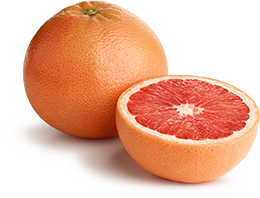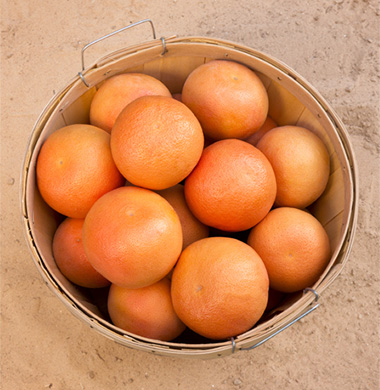
Wonderful Sweet Scarletts Grapefruit
Our Texas Red grapefruit are not only non-GMO, they’re also the juiciest, reddest, and sweetest you’ve ever tasted. What’s even sweeter, just half of a grapefruit is an excellent source of vitamin C and has only 70 calories. They’re the sweetest way to start your day.

-
Key Attributes of Grapefruit
- Juicy with a sweet, tart, and tangy flavor
- Peel ranges from pale yellow to pink
- Pulp ranges from nearly white to deep red
- Available year-round, peaking from November through April

-
The History of Grapefruit
Compared to the rest of the citrus family, the grapefruit is fairly new. As the offspring of the Pummelo, it most likely first appeared in Jamaica in the 1700s, though no one knows for sure. Some have argued that the grapefruit is actually a cross between the Pummelo and the orange, but there are no records to prove this.
The first description of the grapefruit was by Reverend Griffith Hughes in 1750, when he was searching for the origin of the tree of good and evil in the Garden of Eden. He called it the “forbidden fruit” of Barbados. By 1789, that name had traveled to Jamaica, where the fruit was also called the “smaller shaddock.” In 1814, the “grapefruit” was described in writings by John Lunan as a “variety of the shaddock,” and he also called it the “forbidden fruit.”
The grapefruit was actually smaller than we know it today, approximately the size of an orange when it was first discovered. A French botanist named Chevalier de Tussac wrote in 1820: “I have had the occasion to observe, at Jamaica, in the botanical garden of the Government, a variety of shaddock whose fruits, which are not bigger than a fair orange, are disposed in clusters; the English in Jamaica call this the ‘forbidden fruit’ or ‘smaller shaddock’.”
Grapefruit arrived in the United States in 1823 with Count Odette Phillipe, who brought its seeds from the Bahamas to Florida. But it was not until the late 1800s that the public gained interest in the fruit.
In 1870, John MacDonald noticed an unusual tree near his home in Orange County, Florida, and bought all the clusters of the fruit. He then established the first grapefruit nursery with the seeds of that tree. The first shipments of grapefruit arrived in New York and Philadelphia in 1885 and immediately drew the public’s attention. This was the beginning of the grapefruit industry.
Soon grapefruit trees were being planted in other parts of the country, including Arizona, Texas and California, and it wasn’t long before growers began to develop new varieties like those with pink and red flesh. In 1929, a Texas citrus grower noticed a red grapefruit growing on a tree full of pink grapefruit. That mutation, named the Ruby Red, was the first grapefruit to receive a U.S. patent and gave rise to the Texas Red Grapefruit Industry. The Texas Red became the official fruit of Texas in 1993.
Once they saw how popular the fruit had become, Jamaica, Trinidad, Brazil and Israel began to cultivate grapefruit as well.
Did You Know?
Grapefruit got their name because they grow in clusters, like grapes. There have been several attempts to change the name to something with more commercial appeal, but they have all been unsuccessful.
-
How to Care For and Store
Grapefruit should be stored in a cool, well-ventilated area. Typically, storing around 45°–57° F is best. They can stay at room temperature for up to one week. If refrigerated, they can be kept for several weeks.

-
Selecting your Grapefruit
- Select a grapefruit that is firm and heavy for its size
- Make sure that it doesn’t have soft spots or overly wrinkled skin
- Check its scent – it should smell good, not rotten or fermented
- A good grapefruit doesn’t have to have a perfect color
- Skin discoloration, or blemishes do not impact the taste or texture of the fruit

Tips
-
1/2 grapefruit = 4-6 oz. of grapefruit juice
-
1 medium grapefruit = 11 to 14 segments
-
Consume freshly squeezed juice within 48 hours.
How to Enjoy
-
Peel and eat for a quick and easy snack on the go!
-
Toss with cooked shrimp and fresh avocado into a salad to add an exotic twist.
-
Add slices to yogurt for a light snack or breakfast.
-
Mix juice into sauces for a sweet and tangy twist.
-
Chop into vinaigrettes, sauces and relishes.
-
For a summer salsa, dice with cilantro and chili peppers and serve over poultry or fish – or even with chips for a party snack!
-
Or simply cut in half and enjoy!
What We Do

We put a lot of care and work into the citrus we provide. LEARN MORE

We have a wide variety of citrus available year-round. LEARN MORE

Reach out to a member of our sales staff to place an order. LEARN MORE



